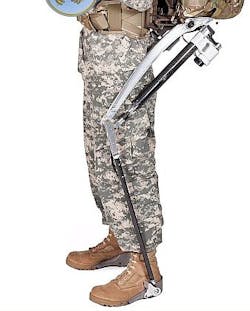SpringActive asked to push forward with developing robotic system to help foot soldiers carry heavy loads
ORLANDO, Fla., 23 May 2012. U.S. military researchers are asking an Arizona robotics company to refine its design of a robotic exoskeleton system designed to help infantry soldiers and Marines carry heavy loads for long periods during military operations while mitigating the risk of injury to hips, knees, and ankles.
The U.S. Army Contracting Command at the Aberdeen Proving Ground Adelphi Division in Orlando, Fla., on behalf of the U.S. Defense Advanced Research Projects Agency (DARPA) in Arlington, Va., announced plans Monday to modify a previously awarded sole-source contract to SpringActive Inc. in Tempe, Ariz., for the Joint Torque Augmentation Robot (JTAR) program.
Military researchers want SpringActive to refine the JTAR ankle and hip designs after testing the first system prototype at the U.S. Military Academy at West Point, N.Y., revealed weaknesses in the first designs. The contract modification will call for SpringActive engineers to re-design the JTAR robotic system so that it fits and works better than the initial prototype.
JTAR stores and releases energy by using tuned springs and by converting electrical energy from a battery to ease stresses on the infantryman's hips, knees, and ankles while he walks or runs -- especially while carrying heavy loads.
Monday's contract action calls for SpringActive to refine the JTAR ankle and reciprocating hip system after biomechanical testing of the first prototypes found improvements could be made in the JTAR system's fit and function, Army officials say.
The contract modification adds four months to the JTAR-development project, and awards SpringActive an additional $210,000 to complete modifications to the system. Re-competing the contract, on the other hand, would cost at least $1.2 million and take about two years, Army officials point out.
SpringActive specializes in robotic systems not only to help foot soldiers in the field, but also in advanced-technology prosthetic limbs to help amputees and the disabled to walk and run normally.
Among the company's military robotic systems is the Robotic Lightweight Load Carrying Exoskeleton (ROLLE), which helps lighten soldier loads with two externally mounted robotic legs that link a modified vest and backpack system to mounts on a soldier’s specialized boot.
The robotic legs use SpringActive’s JackSpring-compliant actuator technology to support the load down to the ground through the grounded leg when the leg is not in the swing phase.
SpringActive also designs the Soldier Power Regeneration Kit (SPaRK), which provides the foot soldier with a capability to generate electric power while walking to augment and extend traditional power sources like batteries.
The SPaRK system, which mounts to the infantryman's boot and harvests energy from ankle motion, serves as an emergency backup power supply when battery power is depleted, and does not fatigue the soldier, company officials say. The SPaRK system can generate a continuous three to six Watts of power output per leg.
More information about the contract modification to SpringActive is online at https://www.fbo.gov/notices/ef853c32f2745f9f207c582df99f9374. For additional information contact SpringActive online at www.springactive.com, or the Army Contracting Command at www.acc.army.mil.
Follow Military & Aerospace Electronics and Avionics Intelligence news updates on Twitter
